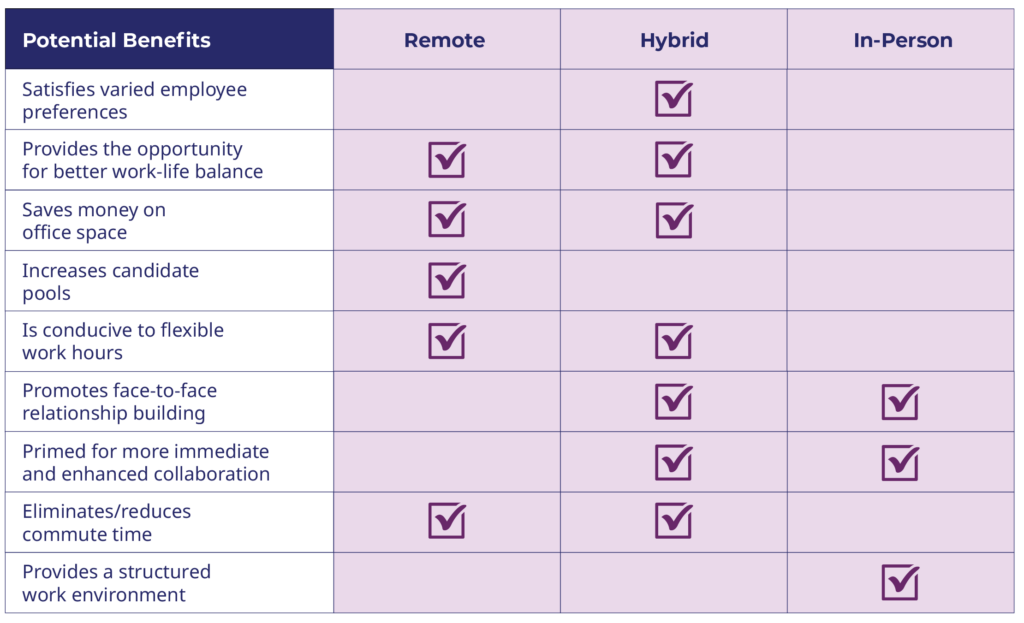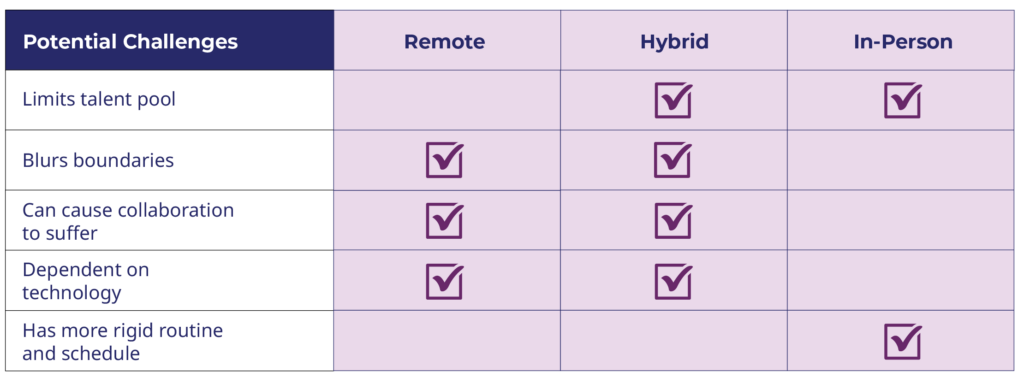In today's world, there's no one-size-fits-all approach when it comes to where and how work gets done. Remote and hybrid work continue to be prevalent within the industry, and some professionals haven’t stepped into their corporate office space in more than four years. Our Q1 2024 Insurance Labor Market Study found just 6% of insurers have implemented full-time in-person work for the majority of their staff; yet, an additional 76% are expecting most employees in the office at least once a week.
Below we’ve outlined the benefits and challenges of each work setup, as a resource for your use as you make adjustments to best support your unique business goals.
Remote/Hybrid/In-Person: At-a-Glance Benefits and Challenges


A More In-Depth Look
While the above chart presents a high-level view of potential benefits and challenges, it’s important to focus on how they will impact your specific organization or team.
In-Person
The traditional, in-person office environment has a number of benefits rooted in more personal relationships, connections and collaboration. As an employer, it’s easier to have daily visibility, understand work styles, and gain transparency into how and when work is being done. Being able to walk over to a colleague’s desk to ask a question or collaborate on a project can help enhance efficiency and facilitate real-time decision-making. There’s often more interaction across departments, as well as opportunities to have impromptu conversations and brainstorming sessions. Shadowing and feedback may happen more organically, as employees can learn from sitting in on conversations and meetings that may not otherwise be possible.
However, these in-office conversations and interruptions may decrease individuals’ daily productivity and output. Additionally, the majority of today’s workforce remains hesitant to take a fully in-person position and may leave their current roles if asked to come into the office even a few days a week. Local candidate pools continue to shrink as companies compete with remote organizations, and access to specialized skill sets is limited.
 Hybrid
Hybrid
Hybrid work may seem like a happy medium between being fully in the office and fully remote; however, it’s important to think through how it will translate for your organization. Employees who are local may enjoy the opportunity to structure their work weeks in a way that promotes work-life balance, while also reaping the benefits of periodically going into an office. For instance, teams may work autonomously most of the week and schedule meetings and time for collaboration during one or two days in the office.
Yet, even in hybrid environments, there are challenges that need to be addressed. If some employees are working in the office and others are remote, it can be difficult to ensure equal opportunities and inclusivity. Time zones and work hours can also become misaligned, making it challenging to schedule meetings and regularly collaborate. Additionally, asking individuals to come into the office even once a week can limit candidate pools as severely as fully in-person work.
Remote
We saw many companies pivot to fully remote work during the pandemic and several are still maintaining this environment. There’s no doubt this option removes geographic boundaries and provides organizations with access to talent across all locations and skill sets. Some companies have given up their physical office spaces completely, saving on rent and other overhead expenses. However, we’ve also seen employers struggle with innovation and collaboration in these environments. It’s essential to be intentional about culture and connecting individuals across locations. Work-life boundaries are also at risk of being blurred, leading to potential burnout, decreased productivity and lack of engagement.
What’s right for you?
As you determine what is best for your team and/or organization, asking the following questions can help ensure you’re set up for success, regardless of your chosen work environment.
![]() Does your chosen work model align with your company's culture and values?
Does your chosen work model align with your company's culture and values?
![]() Does a specific role need to be performed in the office every day to be effective?
Does a specific role need to be performed in the office every day to be effective?
![]() Will certain environments negatively or positively impact employee morale and retention efforts?
Will certain environments negatively or positively impact employee morale and retention efforts?
![]() Are you able to effectively establish and grow a sense of connection and belonging among employees?
Are you able to effectively establish and grow a sense of connection and belonging among employees?
![]() How will you foster effective communication, collaboration and innovation?
How will you foster effective communication, collaboration and innovation?
![]() In what ways will you ensure accountability and productivity?
In what ways will you ensure accountability and productivity?
![]() Do you have the tools and technology in place for seamless communication and collaboration?
Do you have the tools and technology in place for seamless communication and collaboration?
![]() How will you support business goals while promoting work-life balance?
How will you support business goals while promoting work-life balance?
![]() Will there be limitations on your talent pool, and if so, how will you adapt?
Will there be limitations on your talent pool, and if so, how will you adapt?
Each work model presents its own set of advantages and challenges. However, by taking a thoughtful and strategic approach, you’ll be best prepared to create a space where your teams feel valued and are able to collaborate, communicate and thrive.